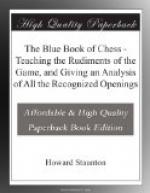[Footnote A: NOTES BY W. STEINITZ.—White’s game has been modelled chiefly after Steinitz’s favorite attack. Here, however, 7. P. takes P. is preferable, for if 7... P. takes P; 8. B. to Kt’s 5th, B. to Kt’s 2d; 9. Kt. to K’s 5th, with a strong attack.]
[Footnote B: As often shown in my annotations in similar positions, it is absolutely injurious to White’s game to allow three well-supportable Pawns against two to be established on the Queen’s side. The prospect of a King’s side attack on which White speculates is quite unreliable in comparison to the disadvantage on the Queen’s side to which he is subjected. At any rate, Pawns ought to be exchanged first, and thus Black’s centre weakened.]
[Footnote C: It was better to make sure of his superiority on the Queen’s side by P. to B’s 5th at once.]
[Footnote D: He had sufficient force on the King’s side to ignore any hostile attack in that direction, and systematic operations on the other wing, commencing with P. to Q. Kt’s 4th, were most in order.]
[Footnote E: The combination of this with the next five moves, more especially with the two closely following, is full of high ingenuity, which, however, is wasted on an imaginary danger. For all purposes of defence it was only necessary to advance P. to K. Kt’s 3d at the right time, and then to play R. to B’s 2d, followed by B. to K. B’s sq. eventually. The Queen’s wing was still the proper point of attack to which he should have directed his attention more promptly.]
[Footnote F: For aggressive purposes on the Queen’s side, the Queen was better placed at B’s 2d.]
[Footnote G: This rash attack and Black’s timid reply were only to be accounted for as results of time pressure on both sides.]
[Footnote H: There was not the slightest danger in capturing the Pawn with a Pawn ahead, while this loses one.]
[Footnote I: A fatal miscalculation. R. to Q. B’s 8th led to a most probable draw, for if 38... R. to Kt’s 5th; 39. Q. to B’s 6th (ch.), &c.]
[Footnote J: Black seizes his opportunity with scientific exactitude.]
Between Frank J. Marshall and D. Janowsky.
{PGN 70}




